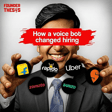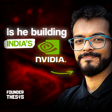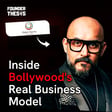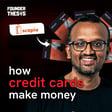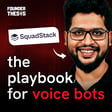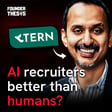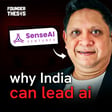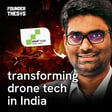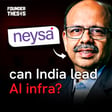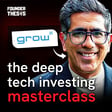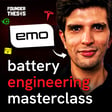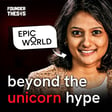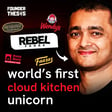00:00:00
Speaker
Hello, everybody.
Rajesh Shait's Unique Founding Story
00:00:01
Speaker
and This is Rajesh Shait, co-founder and CEO of Sahib Andhu, India's largest gold loan aggregator platform. Pleasure to be here.
00:00:21
Speaker
Regular listeners of the founder thesis podcast would have heard so many stories of young founders who have built their ventures straight out of college and kept at it for a decade until they find success. This story is the exact opposite of that kind of story.
Sahibandhu's Rapid Growth in the Gold Loan Market
00:00:36
Speaker
Rajesh Shait had more than two decades of experience in the corporate world when he started Sahibandhu. And that is the reason why in just four years, Sahibandhu has overtaken much older and better funded rivals to become the goal-known aggregator with the largest monthly disbursements. In fact, their closest competitor has raised almost $200 million dollars over the last nine years. This phenomenal achievement is on the back of a hyper-focused strategy that was executed to perfection by Rajesh and his
Exploring the Gold Loan Market in India
00:01:04
Speaker
team. This phenomenal conversation is a deep dive into the market of call loans in India, the gaps in the market and how Sahib Andhu hyper-scaled by smartly filling these gaps. Stay tuned and subscribe to The Founder Thesis Podcast for more such deep dive conversations.
00:01:20
Speaker
Let me start with ah this question. um You said that Sayyebatthu is India's largest goal-learn aggregator. Can you help me understand what is the goal-learn market in India? like What are the different business models? So I'm assuming aggregator is one business model. So if you can just do a deep dive into the various business models and give examples of companies which are known for the business model.
Significance of Gold in Indian Households
00:01:46
Speaker
Okay, so let me give ah some background about the gold market as such in India. One, no the gold market also is made to the gold household um gold holding in the country. So India holds the largest world only. And historically, if you see um gold has been now one of the instruments of saving and it is always a device, a household, I will remember when say, wishkin the the carma yeah yeah ah It is also um ah a ah sign where people relate to all the ah good things that happen in a family, good occasions, everywhere there is gold glitter. So, ah it's got a lot of emotional attachment to the family values in India. um
00:02:37
Speaker
but Every household and has some amount of gold holdings with them. However, economically they are in whichever category they are in.
Gold as a High-Return Investment
00:02:46
Speaker
So with that background, but India, almost 70% of the Indian population is in rural.
00:02:52
Speaker
So if you look at ah the gold on market asset, ah gold is one asset ah that is always given higher returns in terms of if you invested in gold, there will never be a year where there may have been minor blips, but over a longer period of time, gold always has been in a appreciating asset. That holds gold.
00:03:11
Speaker
What is the average percentage over like a 10-year period? How much does it appreciate about it? So if you look at now recent, ah oh what happened after the budget announcement, if you look at it, over the last six, seven years, it's a pressure turned tenfold. So that's where I think government also has been now
00:03:39
Speaker
per 10 grams, it's come to 6,000 rupees per gram, kind of ah an increase that has happened. So it's a huge ah ah increase, but doesn't happen every ah now and then, but then that's historically has been the trend.
Costs of Investing in Jewelry vs. Pure Gold
00:03:56
Speaker
It's always in the appreciating world.
00:03:59
Speaker
So, this is actually significantly outperforming equity, right? Equity, they say, that's 15% over an hour. But if you invest in a jewellery, what happens? It comes with its own costs. There's a making charge, wastage. So if you buy a gold in a pure form, you get all this apprenticeship. But what happens is people invest in jewellery. So if you look look at all the things that are associated, then it may not be that written. But when people also invest in pure gold in a coin or a bar form, all the government came out with these SGVs.
Alternative Gold Investment Options
00:04:34
Speaker
then they engineer people sold in gold bond sold in gold bonds And government encouraged people to invest in because any gold then it is imported, there's bill. So it's as high as the oil import bill for the gold. um So government encouraged the SGBs which is in the digital form and it was linked to the actual gold price. So you can invest ah in a digital form and you can read it at any stage and it gives you annual returns also.
00:05:06
Speaker
um So that's one of the hot topics during after this budget. What happened was ah the price of redemption was linked to that year's price of the gold and government reduced the the import duties on various items, including gold, then suddenly the gold price has dropped ah compared to a few months ago. But still, if you look at the horizon of five years, six years ago, it's still given good returns for an average ah investor. So let me come to... a Yeah, go ahead. Sorry, one question on SGV, then we'll come to that.
00:05:43
Speaker
This is like, it is the same as owning physical gold except the gold is not in your local, it's in the government's local. You have a claim to whatever percentage of a bar that you have invested in. got it Correct, correct. So it's a bar gram, then I think, you know, so I think 100 gram variant or something that, you know, multiples of 100 that they are.
00:06:05
Speaker
You also have an option during redemption now to buy the physical gold of that value. Okay. So that option also exists. And there are these startups which do digital gold. ah yes they also yes the say They are also in the similar space. that is India and other people. And then people also can even loan on digital gold.
00:06:28
Speaker
like With that as an asset. and like Like how you can pledge any of the life insurance or mutual fund or equity, any other assets. so you These are digital gold assets are also something that you can monetize, pledge and take.
Understanding Gold Loans and Their Usage
00:06:45
Speaker
okay so um um With that background, um historically what has happened um from an average ah consumer ah user perspective, there are financial needs that come i across in their life for various reasons. Some could be planned, some could be unplanned.
00:07:07
Speaker
But gold is one instrument historically has been used ah for an emergency or an unplanned financial need. Then rather than going to the standard options that they have could be bank, could be area instrument. Gold is something that even go and pledge and take money immediately and then your requirements are also very short term. Three months, four months, sometime one month and then you pay back and then clear your gold.
00:07:35
Speaker
So this entire trade has been now completely in the unregulated, unorganized space, historically. So you always had some landlords in that area who was like a money lender, who also was a major employer ah for that area. So actually, people tend to go to the same person because their livelihood is dependent on ah the person. But what used to also happen is ah This is one instrument that is hugely exploited by the people who are on the other side, who give the money. So the interest rates are as high as 5% per month, even now in rural India. What happens is, since people take it only for 60%, 50% in the charge, what happens is people don't realize it is the annualized interest that they're paying. They only look at what are they paying for that one month.
00:08:33
Speaker
so um ah For Rs.1,500,000, if they feel it's a small fee, they'll never come to realise that it's a huge interest that they're paying. All they're interested is, ah I'll get money in 10 minutes and then I get money for the full value. Like if the gold value is worth Rs.1,000, they usually get magnifying Rs.200,000 of the dual value.
00:08:57
Speaker
So that's how the trade works. who went questions like yeah You said there is a loss because of making charges and all of that. So the value of the jewelry is already considered those losses. Yeah, yeah yeah yeah i'm I'm considering one lack when I say and there is gross weight and the net weight.
00:09:15
Speaker
Okay. So the net weight is what is considered. If there is started, if there are a few things that they discount and then they're at the net weight and then they calculate that there's a goal value. And then, and I know that has been ah the historical trend. So I'm just giving you a background of the golden industry. So even now 60% of the golden industries in this space, unorganized money lender, pawn breakers, broken space.
00:09:43
Speaker
Where, from a consumer point of view, there is no protection. Tomorrow, if the person, money lender, runs away, or say, I won't give you, there's no paperwork. It is only perci. It's all trust. And if the person is unable to pay, then he'll never be able to get back his asset. In one year, you're paying, even if at a conservative level, it is at 40%. So you've seen that it's not worth paying and releasing it. So that's where people lose their assets also, the family's one.
00:10:13
Speaker
That's the background with which ah the golden industry evolved.
Evolution of the Organized Gold Loan Market
00:10:19
Speaker
Pre-2000 era was, around that era, is where the golden NBFCs came into prominence. They were there in small pockets, but in a big way pan-India, I'm talking about um the industry leaders like Muthur Manapuram.
00:10:36
Speaker
ah So, who nearly revolutionized ah the world loan industry? Full credit to them, though we compete in this space with everybody. But due respect to them, mom they are the one who created a market for world loan in organized space.
00:10:50
Speaker
ah so oh I would say the era for 2000, the decade was all by this um large gold on NBFCs who created a niche product, one product, but went all out because you're required to create um ah the infrastructure that is needed. So it's a highly OPEX um ah a-led model, but then now there is always a demand ah for gold and such that they took the plunge and then they're doing very well. They're the market leaders. So um that is the era of ah the decade of 2000 is all about ah the golden NBFCs. And what is the approximate loan book for these NBFCs?
00:11:38
Speaker
Please note, these values are approximate for FY 2022. I think Muthoot, Bremsen for close to 60,000 crore. Well, okay, that's their AUM. They are the market leaders by far in the NBSC space. Some of the banks have overtaken them, but banks have here size and reach much larger than these NBSCs. But stand alone if you look at the by far the largest player.
00:12:05
Speaker
Manapuram could be half of their size, but they both hold significant market share. 60-70% of that space is held by these two players, and the rest is all law other players. That space you're defining is the retail, organized retail space. like Inorganized, ah ah the NBOCs.
00:12:25
Speaker
no invest yeah ah okay I'll come to the overall market space, ah so market size and 2010 onwards, the banks also failed. This product is now being adopted by customers so well. ah Why did we not even think we have such loyal customer base with us who come in and out, day in and out, because still in rural India, people come to bank branch.
00:12:52
Speaker
every day. So, but then now oh it is all to do with how do you simplify the product and the service delivery for loan. People do not want to wait whole day for a home loan or a vehicle loan. You have a lot of time where the bank manager just says,
00:13:08
Speaker
itnaho burmahe yeah supporting documentsary ab dain magja yeah so it is all planned. People are, but in this case, they want it then and there. But banks were not designed to give that kind of service. You you know now things have changed, but banks are having a certain style in their office hours, the way paperwork, due diligence and underwriting. So they were not designed to kind of provide this kind of service, but then they realized ah ah there's a huge yeah difference between what banks can offer versus what MBSes are charging.
00:13:39
Speaker
NVFCs have seen how to operate at a higher cost, upward of 20% analyzed. So, it anywhere between 20-24% is where NVFCs are charged. Because they have to recover everything from this one product, unlike banks who have bouquet of both liability and asset side, 20 different products in loans.
00:14:01
Speaker
So that's how the pricing is done. But from a consumer point of view, who used to pay 4% per month or 5% per month, NBFC gold loans are still a good bet because it is half the cost. You can look at 2 to 2.5% per month in what at a higher level is people charge. But banks would charge as low as 1.25% per month. ah They have a cost of funds that are very, very low compared to the NBFCs.
00:14:26
Speaker
So that's where banks aggressively post the era of 2010 decade was all about banks also coming into this space. Slowly they were catching up by publicizing this product because gold loan means then you'll have to build ah the gold loan infrastructure within the bank. There should be a valuation system, storage, entire process, ah the software that is needed in their core banking, um lending model system.
00:14:54
Speaker
So all that they had to build and then it can't be done overnight that all by ah bank branches will be golden and equaled. So they'll have to do it in phases. So that's where private banks came into picture. They took the plunge. ICC bank was the leader. And of course, south base, all the private banks so were always leading, but their presence was ah much smaller geographically also.
00:15:16
Speaker
So all the prominent banks started offering gold loans and then slowly public sector banks also ah started offering. But then there is always so ah more a difference between under organization organized when it comes to gold loan. RBA, it's a regulated n environment, went both for NBSC and banks. So RBA has a LTV norm, loan to value. So that is capped at 75%.
00:15:41
Speaker
So anyone wanting a loan, they cannot get more than 75% of the net gold value. So unlike a money lender who can promise them, I'll give you as high as 95%. When it comes to this kind of product, somebody i' giving an example of a 1 lakh net gold can get only 75,000 maximum here. That also most of the banks peg it around 70 to 72%. So they'll get 72,000. Assume that somebody wants 90,000. They won't get it. But in a money lender, they have an option.
00:16:10
Speaker
So ah banks had to compensate this by offering a lower ah ROI and say that you can bring a little additional world, but ultimately you're going to save money because they are going to pay half the cost that you would have been paying to an NDBFC world-owned service provider. So that's how banks position themselves, but then they had to steal the services. well yeah bo The RBI requirement of 75% is only applicable on banks, not on the NBFs. Banks as well as NBFs. So the other organized sectors ah does not have to follow this. doesn doubt Yeah, it doesn't have to.
00:16:49
Speaker
Okay. So during COVID, interestingly, this was one of the product that was picked up because there was a lot of distress, economic and um many people, small traders, every household. This is one product that really took off and we were fortunate to be there at the right time. And this business really grew at that stage. Only for that year, RBI made an exception where the banks were allowed to lend up to 90% entity.
00:17:18
Speaker
not iia Okay. That year, really mini the banks took major share out of NBFC alone because they were not allowed beyond 75, but banks are allowed 90%. And the gold price also had increased. It was like double benefit the banks had. So people who had gold could get more because the prices have increased as well as the entity. So that's that's where where the banks played their roles and they also tried to improvise whether we can give the loan in less than one hour, less than 30 minutes.
00:17:49
Speaker
And the decade of 2020, which is where we are, yeah is ah I would say an era of all the new edge players, fintechs and aggregators.
Role of Aggregators in Enhancing Loan Experiences
00:17:59
Speaker
So we had to um ah really make space for ourselves in a way um because finally we don't lend.
00:18:08
Speaker
Lending is given by respective banks. But then what is that customer will get if they come through us? Like any other aggregate of platform, one, we will give them choice because people will look for choice. Can I go to this versus other bank? um So where we where is the interest rate? Because there is almost some difference. Are there different products, meeting my requirement? but Are there any TNCs, hidden charges? Who will explain? So no one has time um to go to every bank and collect these details.
00:18:38
Speaker
because if you walk into a bank branch also, this is a low ticket, low tenure product. You may not get the kind of attention that a home loan or a vehicle loan customer ah would be welcome. ah So, people will look for an aggregator option whenever ah they are in search of choices. So, as an aggregator, we bring in choices and also the a kind of tech innovations that we can bring in to give that superior customer experience and bring down the overall time. Because if you walk into a brand, there is a time that is needed. But if they walk into a golden NBFC, they will get loan in 15 minutes time. So what we have tried to do is
00:19:23
Speaker
give them that experience which otherwise they would have gone to an NVFC through our platform game and give them the best product and an affordable rate from a bank. It is a win-win for a customer that they're getting both and that's where the the technology comes into forefront and we play so.
00:19:42
Speaker
That's where aggregators have come into prominence. There are not many players. I would put ah somebody like Rupik, who was ah ah one of the first ones to take off in this space. Rupik is also an aggregator. Yeah, so they work with multiple banks at the back end, but they have positioned slightly differently. They try to book loan in their own books also. um They also do co-lending.
00:20:06
Speaker
We also have and NVFC license. NVFC. But our model is very clear where we want to remain an aggregator. So if you look at a pure aggregator who's not having any golden on on their own books, but purely playing a role of an aggregator or facilitating loans for customers, we are the only one in the space now.
00:20:29
Speaker
There are players like India World, whom I would consider a mix of both sides. They are also in NBFC, but then very small compared to our size. Then there are a few new edge players that are coming, they are just too new. These are the prominent names that are there. There are a lot of DSS direct selling agents who are working with banks.
00:20:52
Speaker
who play a role of sourcing leads and passing on to bank, but they don't play any role of offering advice or the choice to customer. They just get a lead, pass it on to bank and expect the bank to close the lead and then they get a fee in count. So we are not in that
Organized vs. Unorganized Gold Loan Markets
00:21:08
Speaker
space. So there are a lot of such players represent the bank, you represent the customer. Correct. That's the difference. So this is the market overall. So if I have to put a number,
00:21:19
Speaker
So the organized market versus unorganized is about that range, so still ah predominantly 60% is unorganized. Only 40% is organized. So organized market is and about 55,000 crore loan dispersed per month.
00:21:44
Speaker
oh that's That's the that's the i don't know number as of now. Putting banks and this gold loan, NBFCs, organized mayors all put together. That's the number. 50,000 per month. It's a huge and the overall ah gold loan market for the year is around is the annualized gold loan market.
00:22:12
Speaker
50,000 into 12, so around 6 to 7 lakh is the organized golden market. It's a huge market. From an addressable market perspective, the unorganized market will move towards the golden, which is so two-third to one-third, if you look at. and There's a huge headroom available. And within the organized also, there's a shift happening from um the NBSC to the banks.
00:22:38
Speaker
So we are facilitating both the movements. Why is that shift haptic from NBFC to bank? The interest rate is better that a bank can offer. Yeah, so if you go come to our website as well as our value proposition anyone, ah we made customer on a 3 lakh loan that they already hold or they wish to take. If they take it bank versus an NBFC, there's a straight saving of 30,000 rupees. Well, okay okay. That's the difference from a consumer point of view.
00:23:08
Speaker
people may not realize they may take the loan and later they may realize that um ah I had a choice here, but then ah how how can I shift now. So we also play an important role in um helping people to gift the loan from an MBFC to the bank by providing the beverage funding. um That is usually a very short term funding for a day or a two day. We have an MBFC kept exclusively for that. um ah So through that MBFC we provide them a personal loan linked to and end use of closing this loan with that condition we provide and then know they
00:23:49
Speaker
ah close the loan and then now they book the loan through a bank that that we take them and then we get the money back to the NVFC. So this is the model overall, the gold loan industry and our know ah no estimate is that in the organized space, eventually almost 20 to 25% of the ah market will be traded through the platforms.
00:24:20
Speaker
but Okay, even though we have ah nothing against and NBFC, there are customers who are in need of very low ticket, 30,000, 40,000, 50,000 rupees. Banks do not want ah directly lemon hotel, but then the cost of operating or servicing such loan is too high.
00:24:40
Speaker
So they don't encourage. So there's always a space if we keep getting such customers and we can take such customers to NBFC also. So the our model will be such that what is best in the interest of the consumer is what we will give. It could be through a bank. It could be through an NBFC.
00:24:58
Speaker
a good and just say Interesting. oh What is a typical customer profile? is it or Let me say, what is the use case for and a goal load? Is it essentially a short-term law?
00:25:11
Speaker
No, so that's where when a tech player comes into a lending space, they bring in a lot of innovation. So we have a lot of data inside. So one key thing that we try to do was, if you look at all the ads, if you look at even now, do you need a gold loan? Come to us. This is the percentage. If you look at the ad. So they assume that people have already decided it's a gold loan. Then here is my product.
00:25:36
Speaker
right And typically they say gold load in five minutes. like the yeah feed which yeah that is what they can get And if you look at the advertisement also, most of the advertisement, you'll find women with women jewelry.
00:25:49
Speaker
yeah historical you foree but that is i mean and a me okay So there are a lot of myths that we have tried to break. ah um People thought um oh ah women will be hesitant to ah ah ah pledge their gold and take money. We have almost 24% of the borrowers who are women.
00:26:08
Speaker
yeah okay Okay. So with their assets, why should ah they be shy of taking rather than going to a money lender or awa friend or a relative and asking money pay worth. Their money, they don't have to ask anything. let them That's one with almost 12% of the jewelry that is ah pledged through our platform. So far we've been tracking type of jewelry. It's a main jewelry.
00:26:31
Speaker
It's a lot of women. So people always thought that a male member has to go to his wife or a mother to say that, can you help me? Don't give you a word. Their own jewel also is something that they can pledge. A card or a chain is worth one hundred and a half lakh and that's their ticket size for the urgent need. So these are the insights that we are able to get. That's where we spend a lot of time understanding ah Where do they use this money? Why why are they ah taking this loan for? That's where the real insight is that moment you realize that people take loans for various ah needs and then the profiling of the customer also becomes very, very important to see who's in need of what kind of so loan. So, people always thought that this is a dismissed product.
Versatility of Gold Loans for Financial Needs
00:27:21
Speaker
ah Yes, it continues to be one of the products where when you are in distress, this is the first recall that will come, but there are a lot of loans so which they plan well in advance and they can take and still use gold loan. So, ah businessmen, small businessmen, traders,
00:27:37
Speaker
who have while usually working capital credit line, they may have from a bank or their own sources, but then that credit line many times gets fully utilized, leveraged, then they need money. Even now with the GST era, they'll have to pay GST by the next month, 15th.
00:27:56
Speaker
So, whether you collect the money from your um customer or no, or GST, you'll have credit to the government. So, they will have shorts on us or um a small ah contractor wanting to bid for a contract wants to put a bid money. So, they will all need money. So, what um we have done is there's an OD product offered by the banks, OD against Worldong.
00:28:20
Speaker
going Okay. So we've seen ah data around data short. Some people are coming every six months. ah Again, they come and every time they come, they have to pay a processing fee. They have to go through that valuation and everything full journey. They have to pay e valuation fee, bank, a loan processing fee. Then we asked them.
00:28:40
Speaker
You seem to be using this for a regular usage, either a short follow working capital or a spike during festival season comes, you want to buy more stock. Why don't you keep this world forever? It's your goal, save in a bank, there's a locker, you're getting a free locker and then get a credit limit. Yes, of course, you'll have to utilize that limit. Otherwise, banks will charge a nominal fee.
00:29:01
Speaker
But then you are you seem to be having a need every now and then. Why don't you use this? And only if you use, you pay. And as you get your money, pay back so that like any other the already product, you're not paying anything. So this is one product which is really picked up.
00:29:17
Speaker
And there is a need that is coming out for a margin money shortfall, be it house loan, be it a vehicle loan, they may fall short by a lakh, two lakh, yeah, down payment for the margin money. So this could be an instrument that they can use.
00:29:33
Speaker
or could be some short for during housing load, everything is done. Now you have a house that is getting built with all the interior and then you're falling short by 6-7 lakhs for the interior. Then this could be a product there.
00:29:49
Speaker
um there are requirement.com for a professional fee, based on engineering medicine, annual, you may have timed your business income or a salary person, but something would have happened. It's deferred by a month or two, but then you have to pay that fee for your child's education during that stipulated time. It could be ideally around April, May, or one more cycle in some time in December.
00:30:14
Speaker
So, people use this money to meet those short-term requirements. They also have requirements related to travel. People who are going abroad will need an initial fund ah for a travel visa application, even in fact when they apply for a visa.
00:30:30
Speaker
You will need to show certain balance in your bank account. yes You want to show that balance, this could be a good instrument. So we work with a lot of travel agents who guide to the people saying that... and upcoti luck but ah but of taka meakna butka in kiba za ahjigar also jamark yeah or there could be some money that they may need ah when they go abroad to settle in till they get the first job and for 3-4 months may settle in and then they repatriate the money back. So, there are various needs and of course health emergency somebody is falling short of money when it comes to the hospital bill.
00:31:04
Speaker
So, ah there are various use cases that have that we have tried to discover. Once we know all these use cases, the personas, then we can customize ah ahl our ah marketing efforts in terms of reaching those customers. Our effort has been to reach the customers before they realize go loan is yeah Golden is a means by which they can solve that problem. We want to be there when that need arises and tell them that Golden is a solution for you.
00:31:34
Speaker
are not the end means. So that's what how we are positioned compared to others and that's where our success lies. But unlike other product where um everything is online digital, this product cannot be serviced or sold online. There is always a physical life that is needed. Somebody has to have a touch and feel of the goal for valuation and take that goal to the bank branch. So you require a hybrid model. That's where ah we have people ah feet on the street that are very, very necessary. So we have to build a distribution large network. That's where we score an edge over others in this model. Rest are taken a bet that the rural market is the one, or suru, the urban-rural market is the one where and there's the largest demand, but it may be slow in picking up.
00:32:27
Speaker
But long term, that's where the market is. So, we've invested hugely in expanding our presence in now these tier 3-4 markets. Now, of course, we are presenting tier 1 and 2 also. um So, straight across. So, some of our peers are there only in tier 1 and 2.
00:32:43
Speaker
It's a large market and you give them immediate head start, but then we feel long term, the market lies in ah the deeper geographies. So you need to have, and and that's where the difficult part comes in.
Sahibandhu's Rural Expansion and Market Strategy
00:32:53
Speaker
Operating in rural India is not that easy. So it takes longer time and convincing also is not that easy. People may not be readily coming forward to discuss about goal-learn requirements. Even now we have stories where our people say when they meet, they will say, but merabao be what butto Yeah. So that's, that's how, or when they come to a bank brand and say, they come umque easternar ah based on the hair bank went into and they way and na own so in a bank, there used to be gold loan counter. We had to give a feedback back to the bank saying that please remove that counter.
00:33:29
Speaker
People do not want to be seen. They just want to be seen that they're sitting there. Because the moment you're sitting in a golden encounter, that means somebody else watches. buta yeah yeah i So there are there are social um complications also, stigma, but that is changing. um That's changing. um now peoples being ah It's my goal. Why should I be defensive about it? People can say whatever they want.
00:33:55
Speaker
But as long as I get value for my asset, I shouldn't be worried about what others say. ah So, this is where from a consumer's perspective, the market socially is also changing, which is helping us. We are also playing an active role in this social change. the Otherwise, the gold is just sitting um at home. You would have realized that our own family is absorbed. All the jewelry is never used.
00:34:21
Speaker
Oh, special occasions you use one or the mid to orbit bother 50% visual maybe just sitting idle. So that's where the next wave e is going to come from rather than keeping that world at home. Why don't you keep that gold in a bank and get a pre-approved old intimate and whether you use or doesn't matter and the gold remains safe and then you have a limit that is there on a click of a button click and I will money when whenever you want don't have to visit anywhere.
00:34:49
Speaker
So this is where but nots coming into picture other index excel i last in order to make but that's so the short of the long story um about the the gold loan industry. Gold loan is typically cheaper than personal.
00:35:08
Speaker
yeah Yeah, definitely because it's a completely security set for a bank. LTV is 75%. Ten urine is one year. So bank will never, yeah even if the gold, ah the loan is ah ah not serviced and eventually it goes through a process of an NPA and auction. You have a 25% cushion and typically banks on a highest level also they keep it at around 17-18% even if they account that it is fully they have not paid. Even then you have a cushion viewer is recovered and the gold is again appreciated. One year period of time the gold would have already appreciated. her So banks will never lose a money lose their money. So typically
00:35:49
Speaker
um around 8 and after 9% goes up to 17-18%. That's the ah range and it's not one time that rate that is there. So it's um it's a unique ah ah product proposition. ah Higher the ticket, to the lower ROI, lower the ticket, higher ROI. That's how it works.
00:36:09
Speaker
Sorry, I didn't understand this. Can you just zoom in a bit on this? Yeah, see, unlike if you take a housing loan, the range could be, they will say 7% to 7% or 8% depending on it. That's the range broader. But then ah it could be a vehicle loan, could be somewhere around 10% to 11% off. I'm just giving an example.
00:36:34
Speaker
ah Personal loan could be anywhere between 14% to 16, 17%. In respect to your credit score yeah created scores. If it is credit score lower, then you'll be charged higher. But when it comes to gold loan, higher the ticket. So if you're talking about a 10 lakh upward gold loan, you will get it as low as 10%. But whereas you take a loan of 1 lakh, it could be somewhere in the range of 16 to 18%.
00:37:02
Speaker
because of the transaction costs. Yeah, value storing, then there's the cost of valuation, then whether it is 1 lakh or 10 lakh, you still have to track, send them reminders, all that. So that's how the industry operates, wherein public sector banks have still not evolved this model. They have kept one standard rate. You come, whether it is 1 lakh, 10 lakh, 20 lakh, my rate is 9%, my rate is 10%.
00:37:29
Speaker
Okay. But then public sector banks so lings are usually lower than private sector. They want to be safer. So they will keep it at around 65%. Public or private sector banks are generally at about 70 to 32%. So this is how the banks position themselves. And compared to um he yeah fixed like, or can you repay, repay it whenever you want to, or is there a penalty for repayment?
00:37:58
Speaker
Ah, so interesting. This is one product. There is no monthly equator installments. This is only, this product is uniquely positioned. You have an option of paying only interest per month. Okay. You don't have to pay principal. Principal, well you pay and elect a new.
00:38:17
Speaker
And there is another product called Bullitt, which is in principle, as an interest, you pay in one go, end of the period. And then, of course, you have the OD product. ah So ah when it comes to ah product proposition, every bank has different nomenclature. In our view, when we have studied the market, when we created the platform, we realized these are the three broad categories.
00:38:43
Speaker
And depending on who's wanting what kind of ah loan, for which purpose, if a trader, then he'll require a OD. If somebody is wanting higher ah money, then better to give a man a product with a monthly installment, interest paying, so then they can get a higher degree. But somebody is having a distress, but then he's sure of getting the money after 3-4 months, when it offers him a bullet product.
00:39:05
Speaker
But rather than using every bank's different product, we came out with our own product proposition. So we sell it as Sahi Max, which is like a maximum LGB that you get, which is a monthly interest scheme. Then Sahi Delight is a bullet product where you have a delight for the customer, where they don't have a headache of paying monthly, they pay another a January.
00:39:23
Speaker
and site flexing is giving the flexibility of availing the voting. These are the three broad categories. Typically, the tenure is one year. They don't give but beyond one year, though some of the banks so i have advertised for a longer tenure, but then typically it is a one-year tenure, but repayable anytime in between. so There are three penalties by some banks ah only if they close within a month, within two months, within three months.
00:39:52
Speaker
Other than that, there are no pre-closure charges because banks are happy that because you already paid a processing fee and then you serviced it for X number of months, then they are okay. So typical average tenure of gold on industry in a bank is about eight months. Okay. okay interesting Interesting. You also spoke of your digital outreach strategy that you want.
Sahibandhu's Customer-Centric Approach
00:40:16
Speaker
to make the customer a gold or there's a solution to your need. You want to reach him when he needs money. Correct. Can you tell me how you are executing? It sounds like a very hard thing to do. It's not that easy. See, what we're trying to do is, I'm just giving an example. People use this for traveling abroad.
00:40:41
Speaker
Yes, they may not have thought. So, what we have tried to do is go to these touch points where they may seek assistance for ah ticketing visa everything. So, the gold loan is not in the picture at all.
00:40:57
Speaker
So there, go and engage these travel agents, make them our agents, advisors, and say that whoever the customer is coming to who is in need of urgent money for Visa or a bank value, then just give our number and we have a small poster that is put there. So and you are reaching to them even before they think of a gold loan. Gold loan becomes a solution. The problem is that they need money. So ah that is one example. Could be where there is well During the education season, especially, there are tutorials. A lot of students, co-parents come there, right? So that's an area where you advertise. People may not even think that gold loan could be an option. What a professional college fee, which is as high as 3 lakh, 4 lakh, in a year that they have to pay. So these are the things that we are trying to do. The same works for online. So online, when somebody searches for a gold loan,
00:41:50
Speaker
Definitely our ad can come. yeah That's a standard given proposal. But then what is when somebody is searching for an educational loan or a foreign travel assistant searching, there also our ad comes.
00:42:03
Speaker
right or looking for handy mode to Bali. and could be Could be anything where um there is money requirement involved, but and around these six, seven broad categories that we are thinking, where we should, our name should be visible. Now the gold loan as an option should be visible. That's the shift that we are trying to do. How much of your sourcing is through these channel partners, say travel agencies?
00:42:29
Speaker
So I would say see our ah almost 74% of our um sourcing is through agent network. So though I said we have a piton seat of close to 500 people, we have another 3000 agents in the field and they are on virtually mapped to these each of the location through this SBO. Out of its 3000 roughly last year, we were at about 100 active agents, I would say advisors.
00:42:57
Speaker
who have given us leads and whom we have paid. There are many agents would have given leads and then now they may not have got converted, but the active agent base is about 1000, close a thousand to 1200. So, in that, if you have to look at various categories, the highest category is the category of agents so who are in the space of already um ah providing some financial assistance. Okay. So they could be jar and ah insurance agent, housing loan, could be a personal loan agent. So there are a lot of people who come in for these products and their loan doesn't get approved. Personal loan reject is the ideal case for us. So then if he is the same person who's already our advisor, then he'll say,
00:43:44
Speaker
upco ah sha incap capacity me me So that's how it is. So we have ah even the agents are um categorized into various buckets and then we actively work with them to help them. We give them all the marketing materials. We train them how to position this product, make it as easy as possible. We don't expect them to send too much. They are um the first hand where they source the need and then they pass it on to our network and then we pass it back to the HBO. Then the real sending happens to our people.
00:44:19
Speaker
ahm Interesting. ah You said that Rubik's model was different from yours. What is the difference in their model? They are more urban focused. They are more andbo focus urban We respect competition. So now we they transistors. Initially, they created a niche for our doorstep banking. It was only one product or one offering that went believing that the doorstep is the model. And doorstep comes with its own complication and costing. So they had to price it also higher.
00:44:50
Speaker
So, after some time, ah you cannot have all the customers fit into. There are customers who will say, name and government say mujaank ya and so then they didn't have that portal. We wanted to keep it flexible simple um and we will give the choice. So that's one difference in terms of servicing portal.
00:45:13
Speaker
ah one um ah We have to be very careful in an aggregation now morning. um Maybe as the platform evolves, then you will have scope to charge fee ah to customer. But when it comes to especially this product, which is a low ticket product, you cannot be seen that you are charging customers from too many aspects. Customer also will see who all he's paying. So we were very clear in our model that we will not charge anything to customer.
00:45:40
Speaker
They should be seen that they are paying only to the bank, only to the one party, because otherwise they think, that's the change from RUPIC. Their model was initially that they were also charging a service fee, which RBI came out with the regulation ill about a year ago, saying that the aggregate of platforms cannot charge anything.
00:46:02
Speaker
to the customers. Yeah. So it is only the banks who can charge. Okay. And another key change was um all the NBFCs had a typical model of so giving the product at a rate, 24% interest. I'm just giving an example and then saying that, the acom communityri made the ah thus person upco al but if you default, then this 14% will become 24.
00:46:27
Speaker
I'm giving you a discount model. It was like a typical, any other startup ecosystem, e-commerce model where you are playing around the psyche of for discounting the product. But in loan, it's where it becomes very complicated after sometimes. So we were very clear there also that we will keep it very simple. Whatever in the bank charges, that's the rate they'll get. That's not getting to any reward because then you will have some um ah money that you'll have to burn only for the cashbacks.
00:46:57
Speaker
which is not a long term because once a customer is used to that then every customer will expect that if by then where will you make money or finally you have to earn out of the loan that is given to the customer. So ah that's another fundamental change there also RBI came heavily a year ago. So it was all linked to this same one aggregator cannot charge another race there cannot be any jumping rate.
00:47:21
Speaker
You have to send the loan rate up rate and that rate cannot change retrospectively. You can always come with a product which says if you default 1% penalty, that should be explained. There cannot be an hidden charge. That's another change from their business model and of course they were um mainly in tier 1 and 2.
00:47:37
Speaker
and they had their own um ambition of building their own book, colliding various models. ah So, we were very clear, we ought to keep it hybrid. We will be purely an aggregator where we book the loans through banks.
00:47:53
Speaker
At some stage in the future, we are open. We are also exploring actively whether well that's where we have kept an NBSC within our reach and as in when that is needed, we'll bring that under our score. These are the changes that we have done.
00:48:09
Speaker
They were heavily betting on the digital strategy, which is very, very expensive to acquire a customer, but the discounting really made initial years. They got a lot of customers, but after some time, if the discounting is not there, we look at customers, then that's a real challenge. ah The spend that you do on a digital channel versus the returns, it's very, very expensive. So that's where we don't see it becomes much more economical compared to a digital strategy, but you have to have both.
00:48:35
Speaker
ah So that's these are the changes that comes to my mind. like Interesting, interesting. what What is your book size today?
Sahibandhu's Growth and Strategic Position
00:48:43
Speaker
So we disperse close to now 400 crore per month. So we cannot say purely book size, we go by disbursement per your book. oh But then just to give you some number, but overall all ah we have done 14,000 crore disbursement.
00:48:58
Speaker
Versus our nearest competitor could be around 17,000 to 18,000 crore, but they had a seven year tenure. We have done it in four years. If you go by the performance per year, definitely we are far, far better than others. Last two years itself, we did close to 9,000 crore.
00:49:16
Speaker
Oh, wow. Dispersement. Okay. So that's, we have been growing close to seven to eight percent percent month on month. That expansion is more to do with, we expanding to newer geographies as well as the locations where we are present, ah we are doing more per location, formulation of for both. So ah this year, our aim is to reach close to about a thousand crore per month to disperse like That's the target that we have.
00:49:45
Speaker
We should make you the largest in terms of birthday disbursement. As of now, in the last six months, if you track multi-disbursement, we have overtaken others. They are very close to our number, but by you only need the monthly disbursement number, last six months, we have retained the leadership.
00:50:03
Speaker
Amazing. And with very little noise. Yeah. So and we are not we are not so ah yeah not heard in the investor circles um as much as others. Yes. We are also no looking for raising capital for growth, but we are very clear that we are not seeking capital for the burn. Yes, ah there is an initial capital that has been ah ah funded by Manipal Group, which keeps us going. There's a commitment to supporters. In such time, we raise external capital, but we're very clear that we want to reach a certain size or state, get our financial fundamentals right.
00:50:52
Speaker
and then now look for raising the capital which will accelerate the growth. We are not looking for our capital too fundable. So that's where we are.
00:51:04
Speaker
and So you are an old Manipal group, and it's it's been two decades almost. Yeah. Can you understand? but I mean, you know, we've all heard of like say, that type of group. These are like very large, but Manipal group is also in itself a fascinating case study of a a home growth in conglomerate. Just give me like a Quick overview of the group, like what is the background? How did they reach where they are today? I believe there were lots of people being seen as by just buyers also. Yeah, yeah, yeah. One of the most trusted brands, if you see. What is the history?
00:51:45
Speaker
yeah yeah yeah so History goes back to the 1920s. It's a very old now or group, ah more than 80 years old. There are not many groups in the country who are more than 50 years old.
00:51:59
Speaker
yeah this is one group power um who has grown in successive generations. There's a third generation ah in the family now who are managing ah the business. Many times ah there are as the progress of the next generation may have their own, but this is one group ah which is significantly grown generation to generation. So just to give you a background.
00:52:22
Speaker
ah The founding fathers, there were two brothers, ah Dr. Timepy and Upendra Py. They come from a small town, Manipal. The entire town belongs to the group in the coastal Karnataka, where I also belong to. My roots are from that place.
00:52:40
Speaker
ah so um da Interestingly, they come so ah they came from bio relatively, I would say, economically better families. So Dr. Timi Pai was one of the first doctors from that region. And Opedra Pai was a businessman, two brothers. But their mother gave them a message that um they had a choice of going abroad at that stage.
Manipal Group's Legacy and Philosophy
00:53:05
Speaker
yeah But then she was very clear that you should serve the society. She gave them a mandate that you should do one
00:53:11
Speaker
something in ah ah making people financially independent. Other is making them... mount well oh in terms of healthcare, care give them the best healthcare that is possible yeah in the remotest part and Manipal was a small town. And the last was education. So these three things that she said, one is finance, education and healthcare. Those three themes became ah ah the guiding principles for the group and the two brothers um between them created the entire Manipal group and empire, if you see. um ah So right now,
00:53:53
Speaker
ah um it's it's laed with the the education like i i started with the band so It started with the with a bank. Syndicate bank was started by two brothers. Okay. And they started the bank and then took the banking to the remotest part. And interestingly, the coastal Karnataka is one of the most literate regions across the country. You see you will not find and find the best of colleges.
00:54:21
Speaker
ah clean city, everybody's working, no poverty, this entire coastal bank. So that also helped people always wanted to be on their own economically better off compared to others. So where and where do they save their money? So the bank, yeah it was always, the like coastal Canada was known as Cradle of Banking. Five banks originated there at the history. So the corporation bank, camera bank, syndicate, Vijaya and Karnataka bank.
00:54:47
Speaker
Now, of course, some of the banks got burst with the the larger banks. The Karnataka bank still remains side quarter that Mangalore. But that's that's a background. So the Syndicate bank was started by the group. And you mentioned about Ambani and Arani. Ambani has a close connection to the Pai family. Recent, if you see the news articles somewhere, it was published. Birubhai Ambani, when he came to India and wanted i um funding for his business venture and no one was ready to ah provide him the funding. Syndicate Bank, the PIE family was the one who supported him and there were PIE family members on the board of Reliance Industries for quite a long long time. As a guest, they were always mentioned the in our successive, his talks is mentioned that how the PIEs came into his rescue you and no one was ready to believe his vision or story.
00:55:44
Speaker
Okay, so ah from two brothers, um so you get very i still you're not nationalist all yeah yeah no no no and now let government and in raga they nationalized and salt work ah nationalist the bank and so Only the founding tag remains, other otherwise the families don't own anything anymore. But what has happened is, ah then the education came into picture.
00:56:05
Speaker
and the healthcare, I would say ah both almost at the same time. So, customer medical college and the customer hospital came into picture. And one one of the first to private hospitals saw that came in the country completely funded and managed privately. Now, all it is Institute of Eminence. I am of the top five institute in the country. So, just within the family,
00:56:32
Speaker
um Dr. T. M. I. Pye's family continued to focus on education healthcare. So now what you mentioned by Joes is under Dr. Ranjan Pye, who is the grandson of Dr. T. M. I. Pye. So education healthcare care is completely managed by Dr. Ranjan. The other grandson, Upedra Pye's grandson is Gautam Pye, who manages all other businesses of the group.
00:56:53
Speaker
They have clear distinction in terms of where they have to operate, but then they are on the trust of each other at a holding level. But then from my focus, business-wise, there are no cross-foldings. So Ranjan Pai manages all, Dr. Ranjan Pai manages all health care and education side of the group. And Gautam Pai manages, there are, his business verticals start from technology.
00:57:21
Speaker
services. Then there is a media house, which is the most prominent vernacular media house called Udayavani group. That's managed by him. Then there is a home fragrance business, which is very, very large in the perceived candle. Then there is energy in front. What is it called? It's called Akam.
00:57:39
Speaker
Ekam brand is owned by ah the group. Also, ah that's the at a group level. One um interesting aspect of the group is um unlike many of the family and traditional business groups, this is one group but ah which believed in bringing professionals long, long ago.
00:58:03
Speaker
ah So, except at a board level as a chairman there on the group, ah they are not none of their family members are anywhere in the organization, any other the functions. We'll typically find people in finance, purchase, key area.
00:58:19
Speaker
so So, both sides, are be it the other side of the group are, I will speak more about Gautam Pai's group. This is called the Manipal group. um So, from a group perspective, TMG.
00:58:34
Speaker
so um um Highly, but I would say ah they trust in bringing in professionals. So that's how so I'm almost two decade experience so within the group. I'll come to Sai Bandhu journey. How did it start as an offshoot of that? um bless ah ah We are known for trust of oh i our customers could be in B2B space or B2C space. ah Some of them highly confrontational or critical projects are always with Maripal. We don't speak about it because of the nature of ah the business. For example, um
00:59:18
Speaker
Adhar is one of the ah so major projects that we manage from a distribution perspective. ah India's almost more than 50% of the banking cards are done in Manipal. Be it debit card or credit card, you take out your wallet, you'll most likely find the card done by us. I had a role even in that business. I'll come to that later. So interestingly, the card is published or printed. Manufactured. Manufactured as well as the data encoding, everything is done and the distribution also.
00:59:53
Speaker
okay that ah the kind the an envelope that comes to you the ready card is done by Manipar. Okay. Okay, so ah one thing was um since ah we came ah from a banking heritage, ah because of the syndicate bank legacy, so the banking continues to be anything that we do, most of the businesses are catering to the banking space, in including Sai Bandhu if you see now, there is some link, but that is all to do with ah almost last 80 years association with banking cycle sector, so where
01:00:30
Speaker
You take a new idea, go to a bank and say that we are starting this, would you be interested to be our partner? We are welcome because they know if we are getting to something that we would have done, all the homework, we make it big, make it very, very successful.
01:00:47
Speaker
Unlike any other startup ah where no um people may think, gar is ah how to associate with a client, whether they'll be trustworthy, let them get some more logos of the bank, then we'll try out. So we don't have such barriers. So that's how, if you see our platform also, Sai Bandhu, best of the banks are already there from day one. So relationship is always there.
01:01:10
Speaker
so The group ah comes with a core philosophy where i ah trust and transparency is very, very important for us. As a spectro individual and innovation, we are some of the guiding principles which are three generations in the family carry similar principle and they are very, very simple. ah From a promoter, we will not find them as promoters.
01:01:37
Speaker
they are like so ah um If you look at my own experience so ah laststo and in the 19th year now, oh but in the last four while three years, this is an independent venture, I'm running out of Gurgaon, supported by the
Innovation and Leadership from Manipal's Incubation
01:01:55
Speaker
Guru. But even prior to that, my instinct has been always trying something new every three years.
01:02:01
Speaker
So, it's like intrapreneurship within the group. They always encourage the group, encourage new thoughts, trying out new ideas, but then make it successful. We believe that if you have to create value, then you have to have the leadership position. So, every business that we are in, we are leaders. So, there's a large print business. So, that's where Manipal started as a back office for Syndicate Bank.
01:02:31
Speaker
started a print company and then we became a um the print partners for most of the leading banks and then ah there's a publishing related the printing facility that we have division. ah Best of the titles worldwide are done from many parts. So that's again now oh There's a content that is very, very secure. People have to trust you to handle that. Just naming a few Harry Potter, Tendulkar, name any important title that gets done at Manipal. We also have a digital arm of related to print where all the books that go in a digital form also are done. There's a large BPO there.
01:03:12
Speaker
So a lot of businesses, so there are more than 30 units doing various activities, but each business is standing on its own. So in the year 2019-20, the group came out with the concept of so incubating businesses.
01:03:29
Speaker
ah incubation model wherein now they encourage the leaders to come out with new ideas and pitch those ideas, business models to the board and one or two ideas will be picked up incubated within the group like any other startup but we will be given complete freedom to operate like any other startup. Other businesses are morally group-held with the group structure. So that's the model that was created and We all ah together created a business model for Golden Aggregation with the Sahib Vandu was the name, much later. um The name came later, but the business thought came much earlier. I was heading financial inclusion business. And that took me to the remotest part of the country and we grew. We are among the top five. um That's under a brand called MBS, Money Power Business Solutions. I and done that business for five years. That is an interesting part. That is a key correspondence. Correspondence, yeah.
01:04:25
Speaker
One interest with the thought that we are providing banking services and remotest part, but we are only solving one side of the ah yeah problem that giving the access to the bank more from a liability side that real need is in providing them loans, but then banks are also hesitant because you will not find a credible background, fixed salary. um So why don't we provide with a loan offering and Goldloan was another another product that we thought would be the best because it's easier to offer, try out. And that's how the idea of Goldloan came as one small ah business idea that we tried out under financial inclusion. Once that model was successful, then that business was side off. In one January 2022,
01:05:11
Speaker
It became an independent legal entity and then I gave up all my other responsibility and came full time to head this business and we we had to start from scratch. And then we had a core team, um which is already there. and then We all moved together and then the rest of the organization we had to create ah from scratch.
01:05:28
Speaker
And most of the key members were already in Gurgaon. So I thought it would be better to operate from here. Though the operation in Spain, India, we can operate from anywhere in the central office. But then I start, let me re-nocate here, rather than are trying to take everyone to a different place. Then I made a shift here. And then now the journey has been very, very fascinating in the last ah two and a half years for me in Gurgaon, building this great business.
01:05:58
Speaker
And you got make-up of the equity in this ah kind of day zero? Yes, correct. That's how the model works. And now our all the businesses under Gautam Pai have taken this shape ah this morning. So every business has been hived off with the independent CEO, IFAO founder, to run that but business on their own. Amazing.
01:06:22
Speaker
I think this is something which nobody else has successfully shown to work, like like giving father equity on day zero. Most other conglomerates tend to start their equity until a certain stage. They have like an ESOP program, which is different from the father equity.
01:06:40
Speaker
yeah Fascinating. What do you think as opportunities in threat of cyber to be on gold? or our Is gold loan itself a big enough opportunity? there is no need to ah Gold loan is a big opportunity in itself. There's so much to cover, ah so ah significant but efforts will be needed to scale up our goal loan. We will continue to grow. Within goal loan also, we will evolve and create more and more create products. We will ah have more banks participating on our platform. But definitely there are other products that are in the pipeline. So we wish to take other products and services to the customers.
01:07:26
Speaker
So typically we operate ah in rural, so there are large set of agri customers. So there are agri related products that are available. Agri vehicles is one, there are two wheeler as one of the product, personal loan as another product, housing loan. So ah we are exploring these products are to be taken to our customers.
01:07:52
Speaker
Okay. So here's you are essentially leveraging distribution because you already have a customer base. So you can upset other kinds of low products. That's right. That's That's right. And I think the advantage of a name like Sahib Adhu is that it can be used for any product. like yeah Yeah. So we wanted to keep it independent of gold. yeah Good choice. Yes. Amazing. And it carries the name. um It sense signifies the role that we play and we have chosen the word, both combination of Hindi as well as the word that can resonate across the country. So, Bandhu is the values there across the country as like a friend, guide, all and Sahi is the right. So, that's how we came out with the name, Sahi Bandhu.
01:08:42
Speaker
And Sahi resonates in South India also, like Sahi Bandhu. No, no. Actually, Sahi is a Hindi word, but Bandhu regulates well. So it's a right partner or a right mind for your choice. That's how we are positioned. I guess Sahi has been, like, Bollywood has, like, universally understood what Sahi is. Yeah, yeah, yeah, yeah. People readily understand what the name stands for.
01:09:05
Speaker
We have a great team, a young team. We take, we product data. So that's what makes us very special. We've got the best of the talent. We've come from a pressure of college. They've come from our peers. They've come from a different industry altogether. We're trying to create a name for ourselves and be the leader in the segment.
01:09:33
Speaker
So let me end with this question. You have obviously bet this very, very efficiently. In four years, you're the largest in terms of money, this person, right? What are the things that you did, which you think are how to assure love and privilege? Okay, so I don't want to give a mega-large statement here, but then two basics. One is,
01:10:03
Speaker
focus ah is very, very important. Okay. um Be focused and then now Prepare a clear strategy in terms of positioning yourself.
01:10:17
Speaker
um There should not be any confusion in terms of what your business model is, the financial model is. And stick to that principle. Don't try to deviate. There will always be some roadblocks in between. Somebody will say, you try out this, then you'll think, ah maybe I'll. So then if we believe when, like,
01:10:36
Speaker
We were questioned by the board that your entire peers so are having a model where they're charging from customer and you're coming and proposing us that you're not in charge of anything customer. Are you leaving any value on the tip to be taken can and then earn a 10 cash reward? We said no, we have done enough study with 10 customers. We believe this is the model and it proved right.
01:10:56
Speaker
Two years we were questioned every time, are you not taking that which is available on the table? So, one is believe in yourself, stick to that model, go for it and have a clear focus and have ah the right team in place, get the right people for the right profile, back them up, they will all do some mistakes.
01:11:19
Speaker
ah but then now don't lose patience, be there to guide them and be actively involved. ah I would give um and then be very, very capital efficient. We cannot be have living in a world that there is unlimited capital that will be available for us to burn. So we have to build a model having a clear path towards profitability. Eventually, we'll have to give returns to the stakeholders. So that vision should be there very clearly. How are you going to finally make this business financially viable? So I would put it, I think I've covered for our success. There are of course, few things that Tech will play an important role. Tech should be the driving source, not just at the backend, it should be at the forefront.
01:12:13
Speaker
ah Helping the business. ah
01:12:17
Speaker
Amazing. Thank you so much for your time, Rajesh. but

